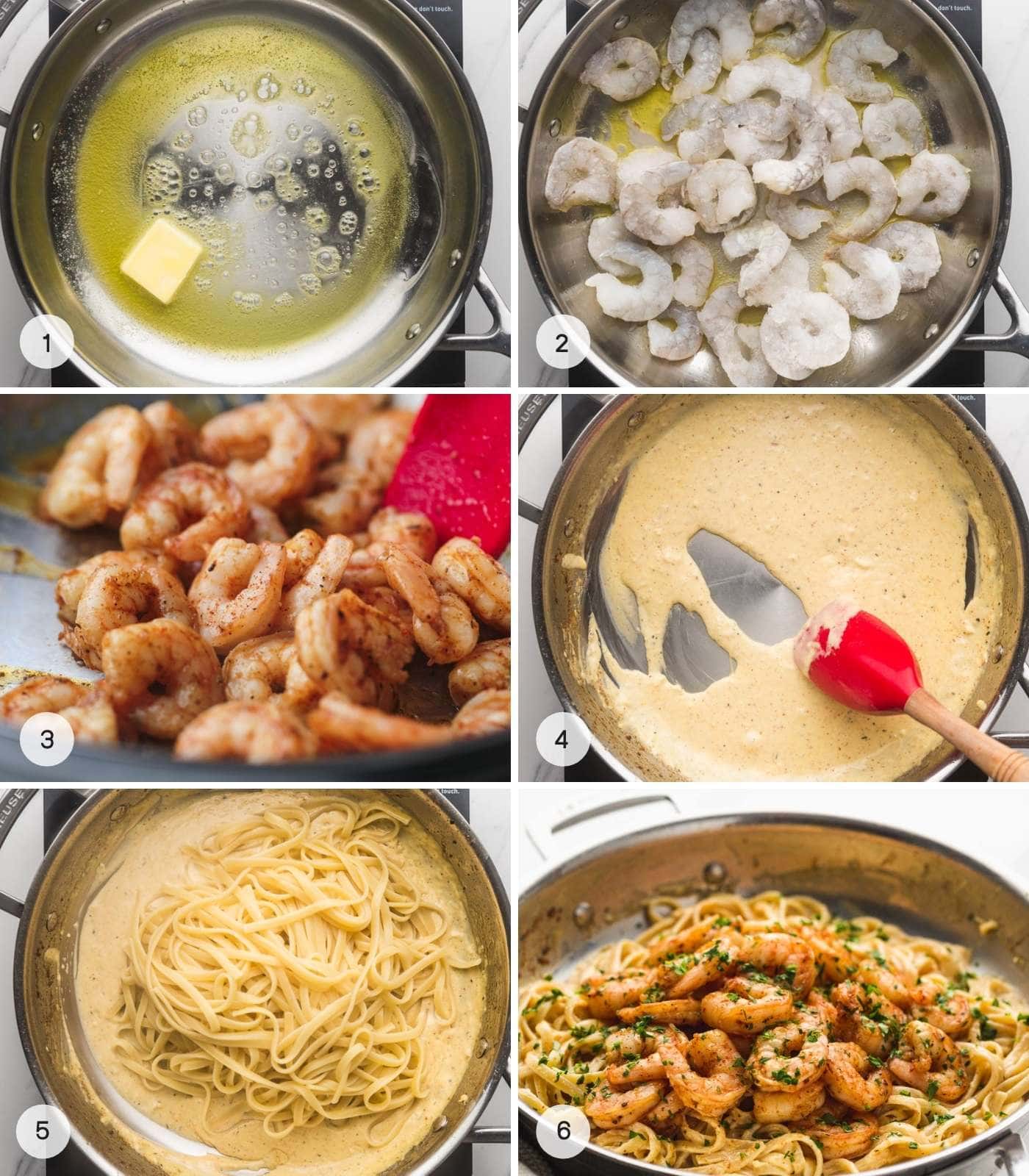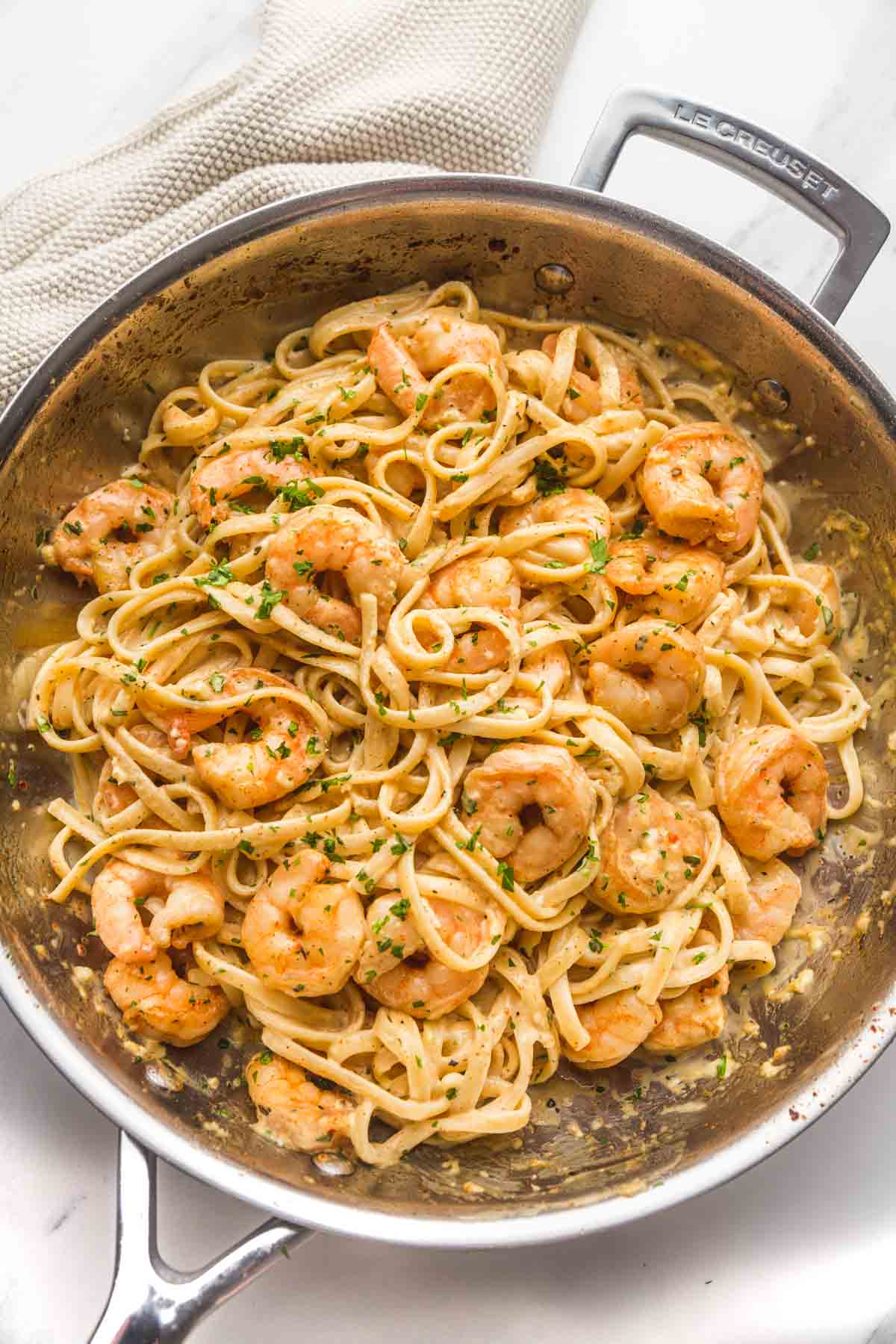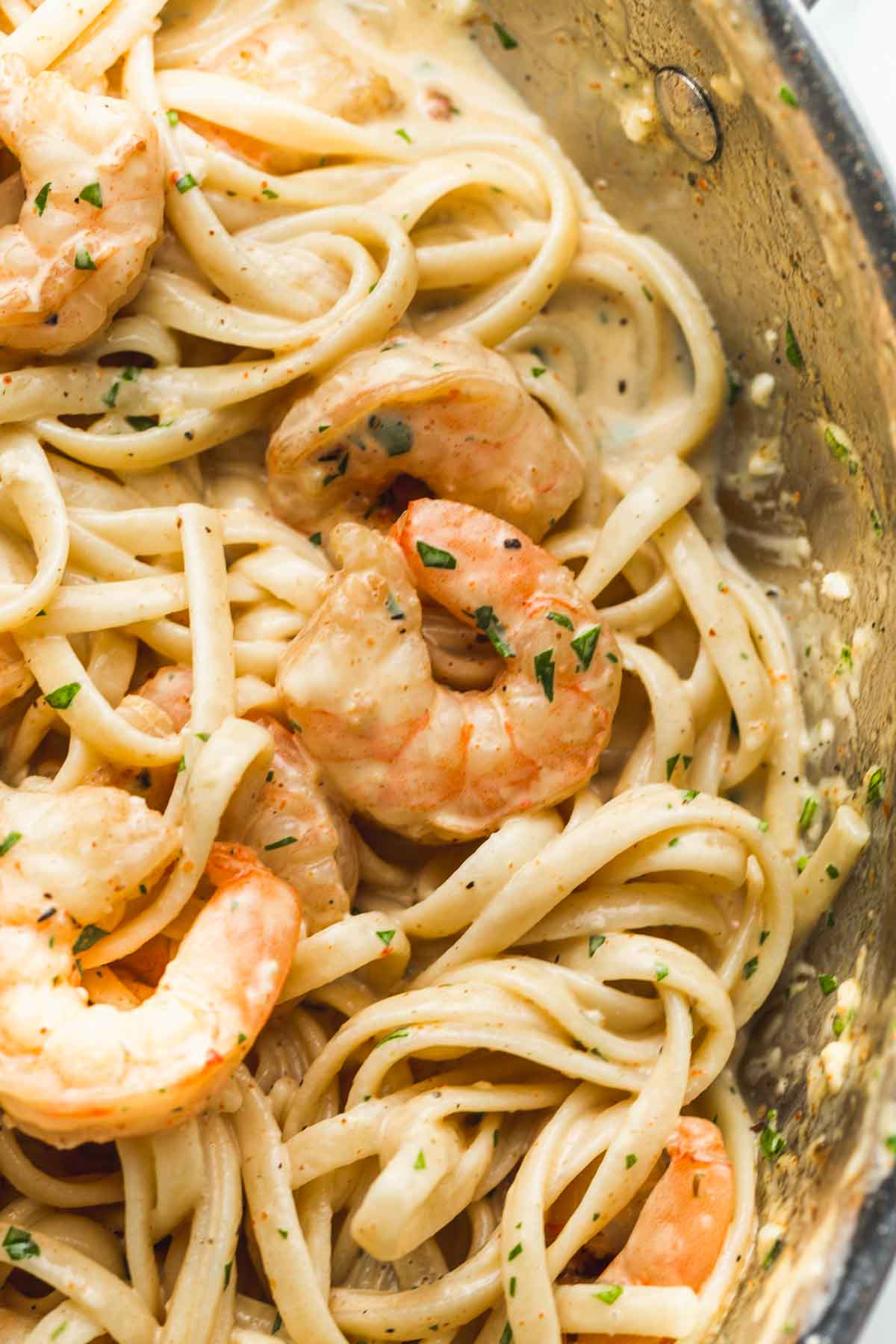This pasta dish is very fancy and has lots of great flavors. It’s also very quick and easy to make, and it’s great for a weeknight dinner because it’s done in 15 minutes. Serve this for a Romantic date night, for a special occasion, or as a family meal. Either way, everyone will love it!.
Succulent butter and garlic infused shrimp sizzling in a flavorful cream sauce, tossed with perfectly cooked pasta. This is where every pasta lovers’ dream comes true ❤️.
I thought of this shrimp pasta after adding shrimp to my garlic butter pasta for dinner one night. I also needed to use up some cream, so I added a splash of cream to make it creamier and richer, and this perfect recipe was born!
It’s REALLY easy, but when you serve it to someone you care about, it will look like you put a lot of work into it. Both the garlicky shrimp pasta and the cream sauce taste amazing, and the textures are just right.
This creamy shrimp pasta is indulgent but not too heavy. And it’s a lot better for you than restaurant food. We all know that restaurant food tastes great because it’s loaded with butter, oil, and salt. But this recipe is lighter, healthier, and still tastes amazing!.
If you’re looking for more creamy pasta recipes, check out my creamy lemon pasta. It’s SO good!
Pasta and shrimp make an amazing combo. The sweet brininess of the shrimp pairs perfectly with pasta’s richness. So can you use already cooked shrimp in pasta dishes? The short answer is yes, you absolutely can use pre-cooked shrimp in pasta recipes. However, there are some things you’ll want to keep in mind to ensure the best results when using leftover or pre-cooked shrimp.
In this article, we’ll cover everything you need to know about using cooked shrimp in pasta, including:
- The benefits of cooking shrimp separately
- Tips for preparing and storing cooked shrimp for later use
- How to reheat cooked shrimp properly
- What pasta shapes and sauces work best with pre-cooked shrimp
- Recipe ideas for dishes using leftover shrimp
Why Cook Shrimp Separately for Pasta?
Many pasta recipes call for cooking the shrimp right in the pasta sauce. So why would you want to cook it separately? Here are some of the biggest benefits
Avoid Overcooking
One of the biggest risks of using pre-cooked shrimp in pasta is overcooking it. Shrimp cooks very quickly, in just 2-3 minutes. If you simmer it too long in a sauce, it can end up rubbery and tough.
By cooking shrimp separately, you have more control over doneness You can pull it off the heat as soon as it turns opaque and pink
More Even Cooking
Cooking shrimp tucked into a pasta sauce doesn’t allow for even exposure to heat. Pieces on top or edges overcook while inside pieces undercook.
Cooking shrimp in a single layer in a skillet or pan ensures every piece gets equal heat contact for perfect texture.
Better Food Safety
Partially cooked shrimp left to linger in a warm sauce is a prime breeding ground for bacteria. Separate stovetop cooking avoids this risk.
Shrimp cooks so fast that you can cook it start to finish right before mixing it with the pasta. This minimizes time in the “danger zone” between 40-140°F.
Fresher Flavor
Cooking shellfish in sauce too long releases moisture, resulting in drier, rubbery texture.
Separate stovetop cooking locks in moisture and gives you tender, juicy shrimp bursting with sweet brininess. The fresh flavor really shines against the pasta and sauce.
Use Leftovers
Pre-cooking shrimp means you can save any extras to use later. Make a big batch to use in pasta, tacos, salads, etc throughout the week.
Tips for Preparing Cooked Shrimp for Pasta
If you don’t plan to use leftover shrimp right away, proper storage is key. Here are some tips:
-
Let shrimp cool completely before refrigerating. Divide into smaller batches in shallow containers so it cools quickly.
-
Drain off any excess liquid released during cooking and pat dry with paper towels before storing. Moisture speeds up spoilage.
-
Wrap tightly in plastic wrap or put in airtight containers. Remove as much air as possible to prevent freezer burn.
-
Use within 2 days for optimal freshness and quality. Freeze up to 3 months if not using right away.
-
When reheating, thaw frozen shrimp overnight in the fridge or place sealed bag/container in cold water for 30 minutes. Cook thawed shrimp immediately after thawing.
How to Reheat Cooked Shrimp for Pasta
To revive leftover cooked shrimp for pasta, use one of these quick and easy methods:
-
Sauté: Heat olive oil in a skillet over medium-high heat. Add shrimp and sauté just until heated through, 1-2 minutes.
-
Simmer: Add shrimp to heated pasta sauce and allow to simmer gently 1-2 minutes just until heated through.
-
Steam: Place shrimp in a steamer basket or colander and steam for 1-2 minutes just until heated through.
The key is to avoid overcooking the shrimp when reheating. As soon as it loses its translucent, shiny appearance, it’s ready. Letting it linger too long in the pan or pot makes it tough.
For best flavor and texture, try to use reheated shrimp in pasta right away after warming up.
Best Pasta Shapes and Sauces
Small, delicate pasta shapes and light sauces are ideal pairings for pre-cooked shrimp. The shrimp’s sweetness and texture stand out against subtler backgrounds.
Recommended Pasta Shapes
- Spaghetti
- Angel hair
- Linguine
- Fettuccine
- Thin rice noodles
Recommended Sauces
- Olive oil and garlic
- Lemon, butter, and white wine
- Pesto
- Light tomato or vodka sauce
- Wine, tomatoes, and herbs
- Artichokes, olives, and sun-dried tomatoes
Thick, heavy sauces can overpower shrimp’s delicate texture. Stay away from rich alfredo, heavy cream, or meat-based sauces.
Recipe Ideas
Here are just a few tasty ways to use up leftover cooked shrimp in pasta:
-
Lemon garlic shrimp pasta: Sauté minced garlic in olive oil and butter. Deglaze pan with lemon juice and white wine. Toss with cooked pasta, shrimp, parsley, salt, and pepper.
-
Pesto shrimp pasta: Toss cooked pasta with pesto sauce. Add shrimp, sun-dried tomatoes, and Parmesan.
-
Cajun shrimp pasta: Prepare pasta. In skillet, sauté shrimp with Cajun seasoning, tomatoes, onions, garlic. Toss with pasta.
-
Shrimp pad thai: Prepare pad thai noodles per package directions. Stir in shrimp, scrambled egg, green onions, bean sprouts, lime juice, and crushed peanuts.
-
Shrimp pasta primavera: Sauté shrimp and vegetables like zucchini, peas, broccoli in olive oil and garlic. Toss with pasta.
The possibilities are endless! Use up leftover shrimp to breathe new life into a basic pasta. Get creative with produce, herbs, and spices you have on hand.
Let’s Recap
While it may seem easier to cook shrimp right in the pasta sauce, separating the steps results in plumper, juicier shrimp texture with purer flavor. Be sure to handle pre-cooked shrimp properly and reheat gently to avoid overcooking.
Opt for lighter pastas and sauces so the shrimp can really shine. And put those leftovers to delicious use in creative shrimp pasta recipes. Just remember—less is more when it comes to properly incorporating cooked shrimp into pasta.

How to Make Creamy Shrimp Pasta
- In a medium-sized saucepan, boil water and salt it. Place the pasta in the pan and cook it according to the directions on the package until it is al dente. When the pasta is done, drain it and save 1 cup of the pasta water.
- Melt the butter in a pan over medium heat, then add the olive oil. For one minute, cook the shrimp. Then, add salt, pepper, and Old Bay Seasoning (or paprika, if you’re using it).
- Continue to cook the shrimp until it’s pink. If you’re afraid the shrimp will get too done, do this in batches. Remove the shrimp onto a plate and set aside.
- Melt the butter in the same pan and add the garlic. Cook for 30 seconds, or until the garlic smells good. Add the heavy cream and use the spatula to wipe out the pan.
- Let the parmesan cheese melt, then add the pasta water you saved to thin out the sauce. Simmer for one minute. Check the sauce to see if it needs more salt and pepper.
- Toss the pasta with the sauce until it’s well coated. Put the shrimp back in to warm it up slowly, then top with chopped fresh parsley and serve.

- Cook the pasta until just al dente. A gentle heat will be used toss the pasta with the sauce. You don’t want the pasta to get too done.
- When you cook frozen shrimp, some of the liquid will come out. That’s okay; it will only take a minute to reduce the heat, so the shrimp won’t get too done. But for the best results, let the shrimp thaw all the way before cooking so it’s as dry as possible.
- Make sure to save about a cup of the pasta cooking water. It has a lot of starch and can help the sauce get thinner. Most likely, you won’t need more than a cup, but just to be safe, I always set aside one cup and drain the rest.
- This pasta makes 4 normal servings, or 3 big ones.

Storage and Reheating Instructions
- Fridge: Put it in a container with a lid and put it in the fridge for up to three days.
- Reheat: Put the pasta back in the pan and heat it over low to medium heat. Add a little water to loosen the sauce. Do the same if using the microwave.
- Freezer: I don’t recommend freezing this creamy shrimp pasta.

How To Make Creamy Shrimp Alfredo Pasta – 30 Minute Meal
How do you eat shrimp & pasta together?
Taste and adjust salt if needed. Combine pasta with sauce and shrimp: Toss in the cooked pasta until fully coated with the sauce. Top with the shrimp and gently toss to combine. Garnish with fresh chopped presley, more parmesan, or red pepper flakes. Serve immediately!
Can I eat raw shrimp?
Eating raw shrimp is not recommended. Raw shrimp can contain bacteria that can cause food poisoning. It is also a good source of purines, which can trigger gout attacks. If you want to eat shrimp, cook it thoroughly to reduce the risk of food poisoning and to help prevent gout attacks. Cook shrimp until it is opaque and pink to ensure that it is safe to eat.
How do you cook Shrimp Pasta?
This Shrimp Pasta, is a delicious fresh herb Italian sautéed shrimp recipe, made even better served tossed with pasta. Fast and easy never tasted so good. *1 cup cooked pasta equals approximately 2 ounces dry. Cook the pasta al dente in a large pot of boiling salted water. Stirring often.
What to eat with garlic shrimp pasta?
This garlic shrimp pasta is a quick and easy meal, accessorized with a green salad or a simple vegetable side dish. To avoid crowding the stove, you may want to try a quick roasted side vegetable like roasted asparagus or roasted green beans.
